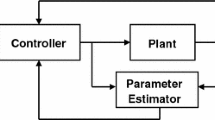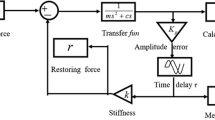Abstract
Real-time hybrid simulation is an attractive method to evaluate the response of structures under earthquake loads. The method is a variation of the pseudodynamic testing technique in which the experiment is executed in real time, thus allowing investigation of structural systems with rate-dependent components. Real-time hybrid simulation is challenging because it requires performance of all calculations, application of displacements, and acquisition of measured forces, within a very small increment of time. Furthermore, unless appropriate compensation for actuator dynamics is implemented, stability problems are likely to occur during the experiment. This paper presents an approach for real-time hybrid simulation in which compensation for actuator dynamics is implemented using a model-based feedforward compensator. The method is used to evaluate the response of a semi-active control of a structure employing an MR damper. Experimental results show good agreement with the predicted responses, demonstrating the effectiveness of the method for structural control performance assessment.
Similar content being viewed by others
References
Blakeborough A, Williams MS, Darby AP and Williams DM (2001), “The Development of Real-time Substructure Testing,” Philosophical Transaction of the Royal Society: Theme Issue on Dynamic Testing of Structures, A 359, pp. 1869–1891.
Carrion JE and Spencer BF (2006), “A Model-based Delay Compensation Approach for Real-time Hybrid Testing,” Proceedings of the US-Taiwan Workshop on Smart Structural Technology for Seismic Hazard Mitigation, Taipei, Taiwan.
Carrion JE and Spencer BF (2007), “Model-based Strategies for Real-time Hybrid Testing,” Newmark Structural Engineering Laboratory Report Series, No.6, University of Illinois at Urbana-Champaign, Urbana, IL, 2007, http://hdl.handle.net/2142/3629.
Carrion JE and Spencer BF (2008), “Real-time Hybrid Testing Using Model-based Delay Compensation,” Smart Structures and Systems, 4(6): 809–828.
Chung LL, Lin RC, Soong TT and Reinhorn AM (1989), “Experiments on Active Control for MDOF Seismic Structures,” Journal of Engineering Mechanics, ASCE, 115(8): 1609–1627.
Darby AP, Blakeborough A and Williams MS (2001), “Improved Control Algorithm for Real-time Substructure Testing,” Earthquake Engineering and Structural Dynamics, 30(3): 431–448.
Dyke SJ, Spencer BF, Quast P and Sain MK (1995), “Role of Control-structure Interaction in Protective System Design,” Journal of Engineering Mechanics, ASCE, 121(2): 322–338.
Dyke SJ, Spencer BF, Sain MK and Carlson JD (1996), “Modeling and Control of Magnetorheological Dampers for Seismic Response Reduction,” Smart Materials and Structures, 5: 565–575.
Dyke SJ, Spencer BF, Sain MK and Carlson JD (1997), “An Experimental Study of MR Dampers for Seismic Protection,” Smart Materials and Structures: Special Issue on Large Civil Structures.
Emmons A and Christenson R (2006), “Proposed Full-scale Experimental Verification of Semiactive Control Applied to a Nonlinear Structure,” Proceedings of the 17th Analysis and Computation Conference (ASCE), Paper No. 4.
Hakuno M, Shidawara M and Hara T (1969), “Dynamic Destructive Test of a Cantilever Beam Controlled by an Analog-computer,” Trans. Jpn Soc. Civ. Engrs, 171: 1–9. (in Japanese)
Horiuchi T, Inoue M, Konno T and Namita Y (1999), “Real-time Hybrid Experimental System with Actuator Delay Compensation and Its Application to a Piping System with Energy Absorber,” Earthquake Engineering and Structural Dynamics, 28(10): 1121–1141.
Horiuchi T, Nakagawa M, Sugano M and Konno T (1996), “Development of a Real-time Hybrid Experimental System with Actuator Delay Compensation,” Proc. 11th World Conf. Earthquake Engineering, Paper No. 660.
Mahin SA and Shing PB (1985), “Pseudodynamic Method for Seismic Testing,” Journal of Structural Engineering, 111(7): 1482–1503.
Mahin SA, Shing PB, Thewalt CR and Hanson RD (1989), “Pseudodynamic Test Method. Current Status and Future Directions,” Journal of Structural Engineering, ASCE, 115(8): 2113–2128.
Nakashima M, Kato H and Takaoka E (1992), “Development of Real-time Pseudo Dynamic Testing,” Earthquake Engineering and Structural Dynamics, 21(1): 79–92.
Nakashima M and Masaoka N (1999), “Real Time Online Test for MDOF Systems,” Earthquake Engineering and Structural Dynamics, 28(4): 393–420.
Shing PB, Nakashima M and Bursi OS (1996), “Application of Pseudodynamic Test Method to Structural Research,” Earthquake Spectra, EERI, 12(1): 29–54.
Shing PB, Wei Z, Jung RY and Stauffer E (2004), “NEES Fast Hybrid Test System at the University of Colorado,” Proceedings of the 13th World Conference on Earthquake Engineering, Vancouver, Canada, Paper No. 3497.
Spencer BF, Dyke SJ, Sain MK and Carlson JD (1997), “Phenomenological Model for Magnetorheological Dampers,” Journal of Engineering Mechanics, ASCE, 123(3): 230–238.
Spencer BF and Nagarajaiah S (2003), “State of the Art of Structural Control,” Journal of Structural Engineering, ASCE, 129(7): 845–856.
Takanashi K, Udagawa K, Seki M, Okada T and Tanaka H (1975), “Nonlinear Earthquake Response Analysis of Structures by a Computer-actuator On-line System,” Bulletin of Earthquake Resistant Structure Research Center 8, Institute of Industrial Science, University of Tokyo, Tokyo, Japan.
Takanashi K and Nakashima M (1987), “Japanese Activities on On-line testing,” Journal of Engineering Mechanics, ASCE, 113(7): 1014–1032.
Wu B, Wang QY, Shi PF, Ou JP and Guan XC (2006), “Real-time Substructure Test of JZ20-2NW Offshore Platform with Semi-active MR Dampers,” Proceedings of the 4th International Conference on Earthquake Engineering, Chinese Taipei, Paper No. 185.
Author information
Authors and Affiliations
Corresponding author
Additional information
Supported by: National Science Foundation Graduate Research Fellowship
Rights and permissions
About this article
Cite this article
Carrion, J.E., Spencer, B.F. & Phillips, B.M. Real-time hybrid simulation for structural control performance assessment. Earthq. Eng. Eng. Vib. 8, 481–492 (2009). https://doi.org/10.1007/s11803-009-9122-4
Received:
Accepted:
Published:
Issue Date:
DOI: https://doi.org/10.1007/s11803-009-9122-4




